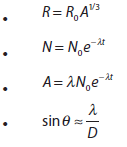|
Nature of science: Theoretical advances and inspiration: Progress in atomic, nuclear and particle physics often came from theoretical advances and strokes of inspiration. Advances in instrumentation: New ways of detecting subatomic particles due to advances in electronic technology were also crucial. Modern computing power: Finally, the analysis of the data gathered in modern particle detectors in particle accelerator experiments would be impossible without modern computing power. (1.8) |
|
Understandings:
|
Theory of knowledge:
Utilization:
|
Applications and skills:
Guidance:
Data booklet reference:
|
Aims:
|


